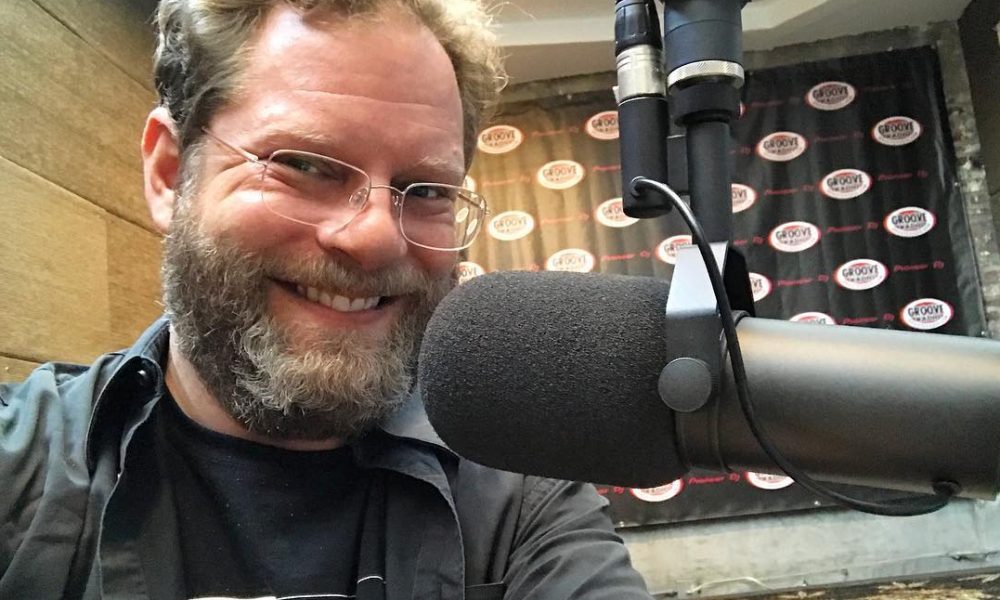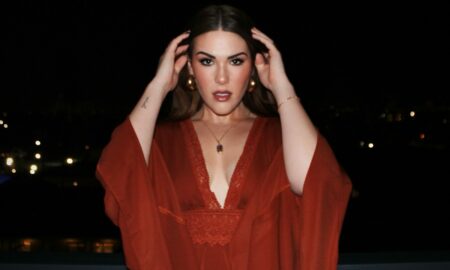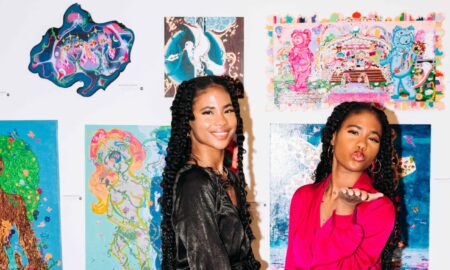

Today we’d like to introduce you to Michael Tullberg.
Michael, can you briefly walk us through your story – how you started and how you got to where you are today.
I began my photographic career in the Hollywood clubs in the mid-1990s. I’ve always felt an attraction to music, nightlife and the underground, so the clubs were a good place to start. Remember that this was in the days of film, so learning the basics of photography in a dark party was definitely not a cakewalk, especially when you had no screens or laptops to check your work right then and there.
I was shooting in several different social scenes in L.A., but in the spring of ’96, I was getting bored. I had my antennae up, looking for the “next big thing” coming down the road. That thing turned out to be the resurgent rave underground, featuring the most cutting-edge dance music to be found in the country. The music in the mainstream clubs was positively anemic by comparison, and I was heartily sick of the douchebaggery factor that never seems to fully leave the club scene. I had my excuse to make the leap, which is exactly what I did.
Over the next several years, I became one of the foremost electronic music photojournalists in North America. I crisscrossed the globe, covering the biggest raves, clubs, concerts and festivals to be found in the electronic music world. This was made possible by all the magazines I was shooting and writing for at the time: URB, Mixer, BPM Culture, Insider, Lotus, and others.
Being in Los Angeles, I was able to insert myself into the very center of American raving culture–both on the business side and on the street. As a result, you would find me everywhere, from the early days of festivals like Electric Daisy Carnival to concerts at the Palladium, to private mansion parties in Bel Air. I ended up shooting album covers for dance icons like Carl Cox and Ferry Corsten. I basically filled the same role that classic rock photographers like Neal Preston and Jim Marshall did, for the electronic music generation. It was an incredible era, a perfect storm of artists, fans, promoters and entrepreneurs.
The era lasted until the mid-2000 and was (as far as I’m concerned) the most significant artistic period in this country since the rise of hip-hop. The fact that this grassroots movement was able to go from the deepest underground to creating the largest music festivals in America was nothing short of remarkable, and I felt a certain responsibility to let the rest of the world know that.
The first step of this was my start at Getty Images in 2004. Getty is the largest news/photo service in the world, and they brought me in part because of my music background. However, they (and indeed, all the other major agencies) were largely unaware of the rise of electronic music in America, and the transition from the rave generation to today’s EDM one. So, I began bringing the major festivals to them, like “EDC”, “Nocturnal Wonderland” and others. When my editors at Getty first saw my tripped-out, total rave overload pictures, they were stunned.
They had no idea about rave culture and were familiar with very few rave artists. That changed quickly when they realized that these festivals were drawing upwards of 70,000 people–it’s pretty hard to ignore those kinds of numbers. So, I became one of the reasons why the mainstream is getting more information about the electronic music world today.
The next step was the forming of my book publishing company, 5150 Publishing. I did this in order to publish my first rave photo book, “DANCEFLOOR THUNDERSTORM: Land Of The Free, Home Of The Rave”. I had originally come up with the concept of the book many years before, but I hadn’t done anything with it until about 2009 when I’d noticed that none of my old photographer or journalist colleagues were putting out any works about the rave scene. I felt that there was a very real danger of many of the crucial stories about the scene’s history were in danger of being lost as a result.
As I said earlier, I felt a very real sense of responsibility to show the rest of the world what the rave scene was really like–not the dank, sordid cesspool that the mainstream media was selling. I had a library of over 100,000 images from those days, so there was no shortage of material on my part. I spent a year shopping around the concept of “DANCEFLOOR THUNDERSTORM”, even while I was putting it together. I got turned down by over 25 different book publishing companies, half of which had no idea what raves were all about.
So, I realized that if this book was going to become reality, I was going to have to do it myself, and I most definitely did *not* want this. I knew nothing about book publishing, distribution or marketing. If I was going to do this, it was going to be a crash course in all of those things, and more. However, in my mind there was little choice: if I didn’t do this, it simply wasn’t going to happen. So, I put together a successful IndieGoGo campaign and raised money to fund the printing of the book. I recruited a pair of my old URB magazine colleagues to take over the editing and graphic design. It took four years, but eventually, we got the job done and published the book in 2015.
Following the successful release of “DANCEFLOOR THUNDERSTORM”, I released more titles under my 5150 brand. There was the interactive Apple iBook “DANCEFLOOR THUNDERSTORM: The Out-Takes”, and the print and electronic versions of a text-heavy book entitled “THE RAVER STORIES PROJECT”, which I produced, edited and released in 2017. In the meantime, I’ve also been working on other projects, like the live photography for Jane’s Addiction’s live album “Ritual de lo Habitual: Alive At Twenty-Five”, and speaking at the EDMbiz trade show.
Has it been a smooth road?
There have been many struggles along this road, in part because the electronic music world was such a tough one to sell to the mainstream media. For much of its history, the rave scene has had a thorny relationship with the media. which has been serving up largely one-sided stories about the scene for a couple of decades now. If you go on YouTube, you’ll find plenty of so-called “investigative pieces” about raves that go back to the early 90s that contain precious little actual investigation.
Like in the music business, the press had difficulties dealing with the fact that there were no celebrities or superstars in the scene to jump all over. They also didn’t take DJs seriously as artists. The parties were taking place in locations that they were totally unfamiliar with (like the desert), and the vibe was unlike anything most of them had encountered in the mainstream entertainment world.
It was this lack of knowledge in the mainstream that made the selling of “DANCEFLOOR THUNDERSTORM” to book publishers such a trial. As I said earlier, half of them had no idea what raves were about. Of the other publishers, half of them didn’t want to touch it (“Rave? Eugh! Too controversial!”), and the rest didn’t know how to market it since it fell so outside their normal realm of experience.
Another struggle, this time in the celebrity photo field, has been brought about by the changing nature of the business, brought about in large part by the Internet. The sales numbers for celebrity images has been dropping over the past several years–the days of snagging tens of thousands for a magazine cover shot are long gone.
So let’s switch gears a bit and go into the 5150 Publishing, Michael Tullberg Photography story. Tell us more about the business.
5150 Publishing is the only American publishing house dedicated to the publishing of works about and by the electronic music underground.
Michael Tullberg Photography is about delivering the highest quality imagery to my clients. In terms of music photography, that means doing whatever it takes to capture that quintessential moment.
How do you think the industry will change over the next decade?
The book publishing business is at a crossroads at the moment. It knows that changes are going to have to be made to its business model in order to survive; Barnes & Noble is the last of the major book chains, and its future is very uncertain. The industry initially thought that e-books and e-readers were going to be the way forward, but sales of these have stalled as of late.
An old paradigm called print on demand has recently been injected with new technologies so that high-quality paperback books can be printed individually, which opens the door previously closed to small publishers who can’t handle large amounts of inventory. And then, of course, there’s Amazon, who holds the whole thing in the palms of their hands.
Media photography has also changed radically over the past couple of decades. The digital revolution has dramatically decreased the time between the taking of the shot and the posting of the photo on a media website. In the case of shows like the Oscars and the like, that time is virtually instantaneous. Because of this, the pressure on the photographer is in some ways even greater than it was in the days of film–they *have* to get it right, and there’s no room or time for error. I see this trend continuing to advance, for better or worse.
Contact Info:
- Website: www.michaeltullberg.com
- Phone: 213-321-5401
- Instagram: https://www.instagram.com/michaeltullberg
- Facebook: https://www.facebook.com/michael.tullberg
- Twitter: https://twitter.com/michaeltullberg
- Other: https://dancefloorthunderstorm.com






Getting in touch: VoyageLA is built on recommendations from the community; it’s how we uncover hidden gems, so if you know someone who deserves recognition please let us know here.



















